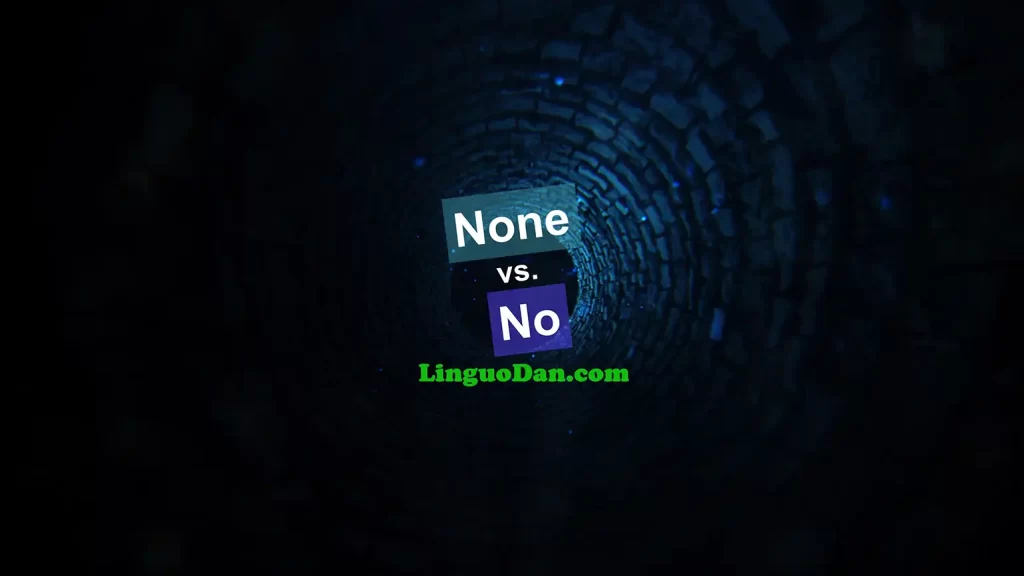“None” vs. “No”: rules, grammar and usage

The difference between “None” and “No” in English
The proper use of “none” and “no” is important for both beginners and experienced English learners. Students often struggle to differentiate between them and use them correctly. None is used to indicate the absence of something within a group or category. It is frequently employed in responses to questions where a quantitative answer is expected. For example:
- “How many cookies do you want?” – “None,” meaning the person wants no cookies at all.
No is used for negation or to indicate the absence of a singular or unspecified number of items or people. It can also precede nouns to denote the lack of something. For example:
- “I have no money,” meaning the person has no money.
- “No students have completed the assignment,” indicating that not a single student has finished the task.
In this article, we will explore the rules for using “none” and “no,” their grammar, and provide examples.
“No” in English
“No” is used to express negation or to indicate the absence of something. It can be used as a standalone response to a question, as well as precede nouns to denote zero quantity or the lack of something.
Grammar
“No” is used before nouns, which can be either singular or plural. It serves to create negative phrases, and when it precedes a noun, that noun is always used without an article. For example:
- “No man is an island.”
- “I have no apples left.”
Usage
“No” can be used in various contexts:
- As a response to a question: “Do you have any siblings?” – “No.”
- To indicate the absence of something: “There are no tickets available.”
- In combination with other words to create phrases expressing prohibition or restriction: “No smoking,” “No entry.”
“No” can also be used in combination with “not” to reinforce the negation. For example:
- “No, I will not go.”
“None” in English
“None” means “not any” or “not a single one” and is used to indicate the absence of something within a group or category. It can refer to people, objects, phenomena, or anything that can be counted or classified.
Grammar
“None” can be used with both singular and plural nouns, although there is sometimes confusion about whether to use singular or plural verbs with it. Traditionally, if “none” refers to an unspecified quantity, a singular verb is used. If it refers to a specific quantity, a plural verb is used. For example:
- “None of the students has completed the assignment” (singular).
- “None of the cookies are left” (plural).
Usage
“None” is often used in responses to questions where a quantitative answer is expected. For example:
- “How many books have you read this month?” – “None.”
“None” can also be used to emphasize the absence of something in a context where its presence might be expected. For example:
- “There were none left by the time I got there.”
“None” can also be used as a substitute for a noun to avoid repetition. For example:
- “There are several options, but none seems suitable.”
Key differences between “None” and “No”
“No”
- Function: Used as a determiner before nouns.
- Usage: “No” precedes either uncountable nouns or plural countable nouns to denote a complete absence of something.
- Examples:
- No water is left in the bottle. (Uncountable)
- There are no apples in the basket. (Plural countable)
“None”
- Function: Functions as a pronoun to replace nouns.
- Usage:
- “None” can indicate a lack of something when replacing “no” plus a noun.
- “None of” is used before pronouns or nouns with determiners (like articles, possessives).
- It can stand alone to respond to questions about quantity.
- Examples:
- Are there any cookies left? None. (Stands alone)
- None of these solutions work. (Before noun with determiner)
- None of it makes sense. (Before pronoun)
Contextual examples and common mistakes
Correct Usage
-
“No”:
- Correct: There are no options available.
- Incorrect: There is no any reason to leave early. (Should be: There is no reason to leave early.)
-
“None”:
- Correct: None of the cakes were eaten.
- Incorrect: None of cakes were eaten. (Should be: None of the cakes were eaten.)
Example Sentences
- I wanted no conflict at the meeting, but unfortunately, none could be completely avoided.
- No job offers were suitable, and hence, none were accepted.